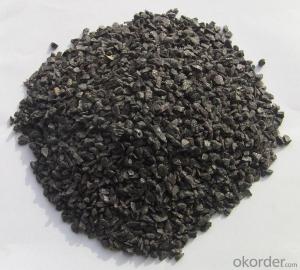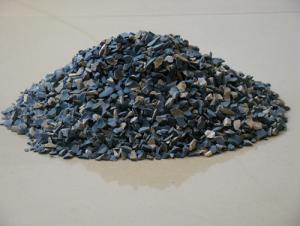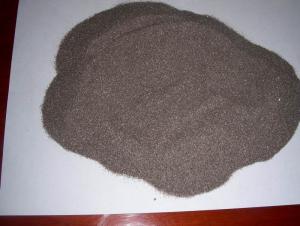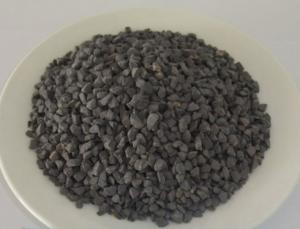Refractory Raw Materials-Brown Fused Alumina Materials
- Loading Port:
- Tianjin
- Payment Terms:
- TT OR LC
- Min Order Qty:
- 20 m.t.
- Supply Capability:
- 1000 m.t./month
OKorder Service Pledge
OKorder Financial Service
You Might Also Like
Brown fused alumina is made from high quality bauxite by fusing in an electric arc furnace at high temperature. It has good toughness and high hardness. It can be used to make superior refractory products.
Specification
Application
Brown fused alumina is used as a raw material in the manufacture of high alumina refractories.
In the same condition, using manganese or silicon to deoxidize separately, the burn out rate are 46% and 37%, but it is only 29% if using manganese alloy to deoxidize. So, it is used widely to smelting steel and its output increases faster than ferroalloy's, so has become an indispensable composite deoxidizing and alloy additives in steel industry. The silicon-manganese which contains carbon below 1.9% still is used to produce medium/low-carbon ferromanganese and semi-finished products of electro silicothermic process manganese metal.
- Q:What types does soft fire prevention materials have?
- Types of fire resistant species. Mainly listed as follows: finishing fire retardant paint, component fire retardant coating, fire-resistant coating for steel structure and othe kinds of fire retardant coating. Flame retardant plastics and its products, textiles, building materials, flame retardant fabric and exterior wall thermal insulation system products, floor materials, such as various types of fire prevention materials;Fire prevention board, fire doors, fire prevention, fire shutter, fire glass window frame, elevator doors, ventilation pipes, fire blocking material, fire smoke exhaust fan and other kinds of artifacts (resistance) fire prevention. Indicators of judging fire mainly include: difficult to fire, ignition, smoke toxicity, smoke density, heat release and flue gas; fireproof performance, combustion performance and combustion heat value, fire resistance, high temperature resistance, fire rating, etc. And some specific parameter is needed to use professional testing instrument to judge, but to the inorganic lab for understanding, fire prevention level test result accuracy.
- Q:Who knows the setting requirements of roofing fire barrier zone?
- curtain wall style architecture should meet the following requirements: The space between the inner cavity of the base wall and curtain wall and base wall, pier?between?two?windows, window sill wall and skirt wall should be sealed by the fire-proof?sealing?material at each floor. I hope I can help you!
- Q:Is there a worker in (Jigang refractory plant)?
- Exactly, you are not in the strict sense of the refractory plant contract worker, your contract is not signed and refractory plant, your wage system, and the worker in the factory is not the same, you can not follow the normal off-duty execution system
- Q:As for fireproofing material rock wool and glass wool, which one is better?
- As for fireproofing effect, the effect of rock wool is certainly better than glass wool , the highest temperature of rock wool is 1100 ℃, but the temperature of glass wool is only 600 ℃. In addition, if it's used in the external walls, then,unit weight of the glass wool is limited,and high unit weight can only be 60-90, but unit weight of rock wool can reach over 140, now external wall can't use glass wool, and only rock wool is A class fireproofing material. glass wool has lower thermal conductivity, rock wool has longer fiber length,as for the price, tons price of glass wool is more expensive than rock wool, but if it's acculated by square, square price of glass wool is cheaper than rock wool.
- Q:How many refractory materials does the annual output of 1 million tons of coke oven require?
- The production of dense synthetic Magnesium Oxide requires many steps, briefly summarized as follows:(1) Mgcl2+Ca, Mg (OH) 2, =Mg (OH) 2+CaCl2Sea salt or brine, dolomite, magnesium hydroxide, residual salt(2) Mg (OH) 2 Mg0 (low density);(3) MgO, Mgo (compact)The resulting compact Magnesium Oxide generally has a purity of up to 95%-99%, depending on the manufacturing process and the final application requirements. As shown above, Magnesium Oxide can be obtained from sea water and slaked lime. The density of the final product is through the high temperature roasting in shaft furnace and the large area obtained by calcination, and the mechanical compaction. Through the pre sintered refractory material to fundamentally eliminate the permanent contraction or extension is extremely important, it is obviously, because we cannot expect excessive contraction or extension in the use of the materials can be used to store the proper degree of molten metal or slag. The production of magnesium oxygen throughout the world (Fang Meishi) large factories in the United States, Michigan by brine well production, and by the sea water production Magnesium Oxide factory is located in Florida, Texas, California and Maryland.
- Q:What is the difference between the fire?rating and the fire resistant level of the fire-fighting equipment?
- Fire rating and fire-fighting rating are the misnomer to the building fire resistant level. The building fire risk is measured by fire resistant level. The article 3.2.1 and 5.1.7 of "Architectural design code for fire protection" have made provision respectively on the fire resistant level of plant (the storeroom) and civil construction. Article 3.0.2 of "Code for fire protection design of tall buildings" has made provisions on the fire resistant level of tall buildings. As for the warehouse building "category malonate", it refers to one of the fire risk of goods storage, which is divided into A, B, C, D, E, and each category is refined depending on the nature of different substances. "Malonate class" specified in article 3.1.3 of "building design for fire protection" refers to the flammable solid.
- Q:what textures of furnace refractories are good?
- The common one uses the ordinary aluminous fireclay brick and GB / T 3994-2005 insulating fireclay brick. The ones with excellet texture are high-grade thermal insulation refractory brick and GB / T 3995-2006 high alumina insulating firebrick, whose model is A13, the texture is alumina, A13 50u, advanced heat insulating brick B5; intermediate heat insulating brick B2, and so on. Dolomite brick: The formation of coating is of good performance and corrosion resistance, but to some extent, there exsits the f-CaO in the brick, which is easy to hydrate, and hard to transport and storage, thus less using in the production. Magnesia-chrome brick: The formation of coating is good, so it is widely used for burning zone, but the disadvantage is poor thermal shock resistance, coupled with the highly toxic positive Hexavalent Cr, so the international countries that produce and use the magnesia-chrome bricks are gradually reducing. The production unit using this brick now, please find alternatives as soon as possible.
- Q:whether the aluminum silicate thermal insulation material is fireproof or not?
- Yes, it is fireproof. Refractory thermal insulation material mainly refers to the inorganic thermal insulation materials and composite thermal insulation materials. According to the shape it can be divided into: Fibrous finishing, mineral?cotton, rock wool, glass wool, aluminum?silicate?wool, ceramic fiber,ect.. it takes the flint clay clinker as raw material, produced by the fusion of resistance or electric arc furnace and the injection of fiber forming. characteristic: Low thermal conductivity, excellent thermal and chemical stability, without binder and corrosive material.
- Q:What dose the fireproof and thermal insulation material include?
- Protective cloth, fireproof cloth, plastic coated cloth, PVC tarpaulin, flame retardant cloth, duct cloth, automobile tarpaulin, PVC protective cloth, the freight yard covered cloth, PVC plastic coated cloth, Industrial Canvas, widely used in automobile tarpaulin, trains covered cloth, ships covered cloth, open-air yard covered cloth, industrial and agricultural covered cloth ; used in glass, timber, fertilizer plants, steel plants, mechanical hardware factories, feed mills, grain storages, container plants, oil refineries plants, packaging plants, paper plants, air conditioning plants, logistics, ore factories, fleet, rail and sea fields, etc.
1. Manufacturer Overview |
|
|---|---|
| Location | |
| Year Established | |
| Annual Output Value | |
| Main Markets | |
| Company Certifications | |
2. Manufacturer Certificates |
|
|---|---|
| a) Certification Name | |
| Range | |
| Reference | |
| Validity Period | |
3. Manufacturer Capability |
|
|---|---|
| a)Trade Capacity | |
| Nearest Port | |
| Export Percentage | |
| No.of Employees in Trade Department | |
| Language Spoken: | |
| b)Factory Information | |
| Factory Size: | |
| No. of Production Lines | |
| Contract Manufacturing | |
| Product Price Range | |
Send your message to us
Refractory Raw Materials-Brown Fused Alumina Materials
- Loading Port:
- Tianjin
- Payment Terms:
- TT OR LC
- Min Order Qty:
- 20 m.t.
- Supply Capability:
- 1000 m.t./month
OKorder Service Pledge
OKorder Financial Service
Similar products
New products
Hot products
Hot Searches
Related keywords



























